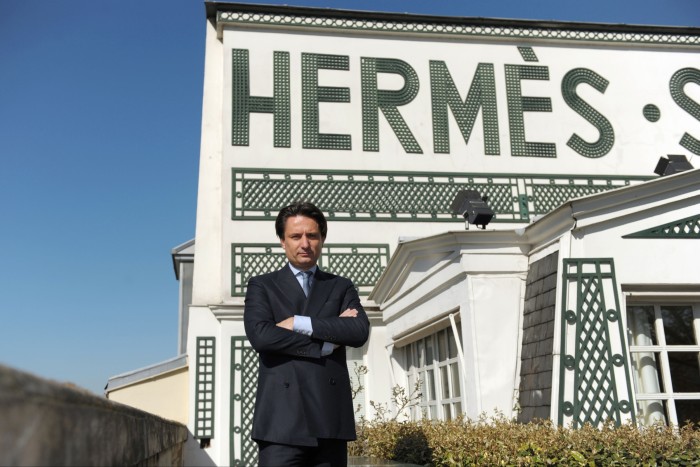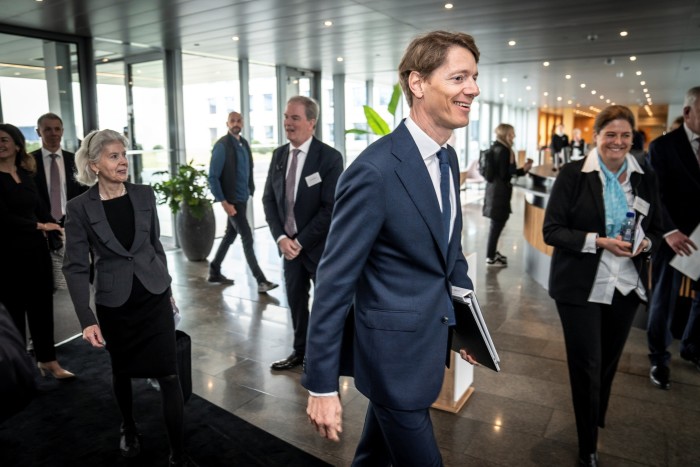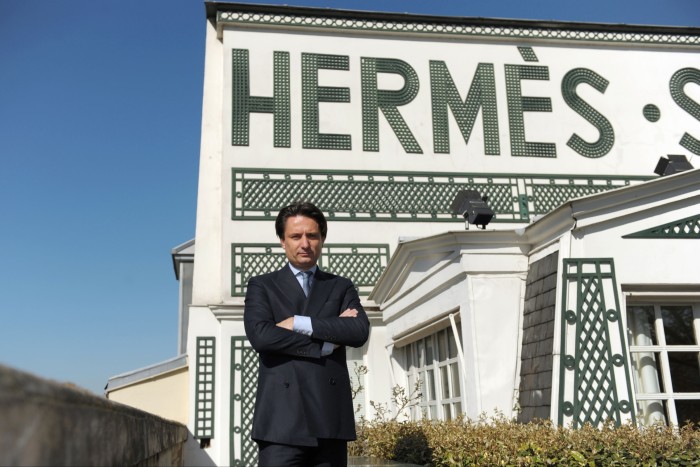[ad_1]
In February 2022, a handful of senior executives gathered in the German town of Mettingen, 50km east of the Dutch border, to discuss an ambitious new strategy for Cofra, the family-owned company for which they worked.
The group toured the family archive and stood by the town’s life-size statues of Tüötten, the local name for itinerant Catholic cloth merchants. In 1841, two of those traders, brothers Clemens and August Brenninkmeijer, set up a clothing warehouse in the Dutch town of Sneek. It went on to become C&A, the retail chain that is Cofra’s best-known brand.
That history is still an important part of Cofra’s story but the executives have bold plans for the future: the Brenninkmeijers’ goal is to move Cofra beyond retail into areas such as sustainable food and clean energy.
To drive this change, the family is breaking with longstanding traditions of self-sufficiency by opening the company to outside capital.
Such a shift is a defining moment for a famously secretive company such as Cofra but it dramatises many of the dilemmas faced by family-run businesses around the world.
Successful family companies pride themselves on what they believe to be their ability to take the long-term view and to maintain a distinctive set of values. They often like to handle their own affairs in private and make their own plans for leadership succession.
But Cofra has been forced to re-examine many of these core principles as it invests in what it sees as the industries of the future — asking how far it will open itself up to attract investment and outside talent.

For listed companies, there are detailed procedures, rules and public debates about how to manage questions of succession and transparency. But for the family companies that are privately owned, the path is often much less clear. The desire to expand and invest can often collide with what are often regarded as family company shibboleths, such as fiscal conservatism, keeping full ownership and passing key management jobs on to family members.
All of this matters because of the prevalence of family ownership. The Family Business Network, an organisation of 4,000 families worldwide, estimates that two-thirds of all companies are family controlled, ranging from small local firms to global entities such as Lidl owner Schwarz, which employs over half a million people.
Family-controlled businesses account for 70 per cent of global gross domestic product, the FBN estimates, and employ 60 per cent of the global workforce. How these businesses balance short-term demands and long-term goals has implications for employment, public policy and prosperity.
Longstanding family firms such as Cofra “live for this idea that if you take over the family business, you hand it to the next generation better than what you inherited”, says Morten Bennedsen, professor at the University of Copenhagen and an expert on family companies.
But Thomas Hagmann, a partner at innovation consultancy Innosight, points out the dangers of trying to avoid these questions. A mindset of simply paying regular dividends to sustain the owners while the company gradually stagnates “will endanger your talent base and your family business”.
Cofra argues that it has little choice. “By opening up [to outside capital], you ensure that you continuously have the windows open and you’re ahead of the wind,” says Boudewijn Beerkens, chief executive of Cofra since 2019 and the organiser of the Mettingen trip. “And that is what it takes to remain competitive.”
Generational transitions
In their bid to remain competitive, no question is more thorny for family companies than succession — and the risks that handing the keys over to heirs can be a path to mediocrity.
Bennedsen says privately held family companies lack many of the governance checks and balances to which a listed company would be subject and do not attract the same level of external scrutiny. The suspicion that a family scion occupies the top job because of their surname, rather than their competence, also haunts such organisations.
The Brenninkmeijers have evolved a particular way of conserving family control and managing succession based on a blend of family and professional management.
A restricted and very private ownership group sits at the heart of the business, nicknamed the Sneekerkring, or “Sneek circle”, after the Dutch town where C&A was born. It consists of roughly 60 family members but its make-up and even the exact number of members are secret. Senior family members move off the “SK” in their mid-50s, automatically refreshing the ownership group.
Until the 1990s, only the sons of former SK members were admitted to the organisation. A 10-point family code, called Unitas, used to state: “Business matters are men’s matters! Ensure that no woman has influence over the business.”
Brenninkmeijer women directly descended from SK members are now able to join the ownership group.
Along with many others, the family have also come to realise that involvement at the top level in the business is increasingly a choice rather than an obligation for descendants.
Economic anthropologist Bridget Kustin, a senior research fellow and director of Oxford Saïd Business School’s Ownership Project 2.0, says 80 per cent of the owners of family businesses to whom she spoke for the project were men over 50 who “knew from a very young age that they were supposed to be in that position”.

But when EY ran a poll of more than 34,000 university students with a family business background in 2013-14, it found only 5 per cent intended to join the firm even five years after graduation.
Having encouraged their offspring to apply for the best universities and MBA programmes, “most families have the problem that the kids don’t want to go back to the family firms”, says Bennedsen. “They want to go to [consultancies] McKinsey or Bain, or start up a firm because they think they’re the next Steve Jobs . . . It isn’t very sexy to go back to Mum and Dad.”
Charlotte, a sixth generation Brenninkmeijer who is part of the Sneekerkring and chief executive of the Anthos Family Office, which advises the wider family on wealth management issues, acknowledges that working for the firm “is only one way”.
“The majority of family members do choose another path and don’t work for the family business . . . I discovered that I did have a passion for business,” she says in an interview with the Financial Times. When the invitation to join the inner circle comes “you need to want it and you need to be able to do it”, she adds.
Beerkens had sworn never to work for the group even though his mother is a Brenninkmeijer. But he says that when the company headhunted him from Dutch conglomerate SHV in 2016, “the cultural recognition was much better than I had anticipated . . . A lot of things [did] not need to be explained”.

Johanna Waterous, a former McKinsey consultant who has served on the board of Cofra and continues to advise it, says that these days family members are pulled towards the group by the sense that “you’re in it to be a force for good”.
But once there, they are still carefully trained and selected for positions in the business — just as they were in the days when young male family members were housed in strictly supervised “households” in company-owned flats or above branches of C&A while they were prepared for important jobs in the company.
Periods spent working or studying elsewhere can help allay the perception of family favouritism that stalks even the distant descendants of company founders. In her book How to Lead Your Family Business, Julie Charlestein states bluntly that it was “an unavoidable, unassailable fact” that she achieved her position as chief executive of Premier Dental, a dental equipment company founded by her great-grandfather, through “nepotism”.
But an MBA and outside experience helped soften any perception she was unqualified when she took the role in 2016. “I was glad that I had worked outside. It gave me an additional level of validity,” she says.
Hired hands
Another option is the “professionalisation” of the business — when ownership stays with the family but non-family managers are hired to oversee day-to-day operations.
The Brenninkmeijers have long done this and significant recent hires include British retail grandee Allan Leighton, who chairs the C&A holding company, and former Ikea executive Giny Boer to run the chain in Europe.
Thomas Brenninkmeijer, a fifth-generation member of the ownership group and a Cofra director, says: “The important thing is that we attract around us a very large group of extraordinarily talented non-family members who have the exact same passion and view of the world and society”.
But problems can occur when a non-family chief executive or chair is appointed who is at odds with the family culture. That has led some firms to reinstall family members in senior roles to ensure continuity and the retention of “family-company” values such as long-termism, conservatism and responsibility to wider stakeholders.

Container shipping line AP Møller-Maersk last year elevated fifth-generation Robert Uggla to head the board to “safeguard the momentum of the strategy”. Luxury group Hermès appointed Axel Dumas as chief executive in 2013, putting the sixth-generation family member in the vanguard of fierce and ultimately successful resistance to Bernard Arnault, whose luxury conglomerate LVMH had built a large minority stake.
Longer-lived family companies have found that being able to choose from a pool of the most competent descendants of the founder combines the best aspects of inside understanding of the business and professional skill sets.
Alexis du Roy de Blicquy, chief executive of the Family Business Network, describes this as “professionalisation of the family as much as of the business”.
Beerkens’ challenge is to execute the family’s plan for the reinvention of Cofra, moving it away from its retail roots towards what he says will ultimately be a holding company split roughly equally between real estate investment, private equity and operating businesses, including C&A.
In 2020 it bought Sunrock, which specialises in large-scale rooftop solar energy projects. Last year, it acquired Dalsem, a developer of greenhouses, as part of its push to support transition to more sustainable food systems.
“Very few businesses say: there’s going to be a problem in 20, 30, 40, 50 years . . . How am I already organising myself today to be able to actually help solve that problem?” says Beerkens.
But diversifying beyond a long-established set of core businesses brings additional risks and often requires additional capital. The Brenninkmeijers came to the realisation that some of that funding would have to come from outside the group. It was a significant moment; apart from the listing of a minority stake in C&A’s Brazil operation in 2019, the family had previously relied mostly on Cofra’s internal resources to fund its growth.
Beerkens convinced the family that by finding like-minded co-investors for assets, funds and joint ventures operated by its wholly owned subsidiaries, Cofra could increase its scale and social impact.
Charlotte Brenninkmeijer says the transition is a sign of how the family company continues “to adapt and respond to the challenges that the world is facing”. The new strategy has excited younger family members and encouraged them to think “they will have different opportunities [in the business]”.
These are important lessons for other family businesses. FBN’s du Roy de Blicquy says that over the past decade there has been an increasing recognition that “nextgens”, as the network calls them, need to be more closely involved in shaping strategy.
Lowering the veil
Younger members of family businesses are also encouraging their seniors to abandon traditional attachments to secrecy about their wealth and operations.
Nextgens “have a different relationship with privacy”, du Roy de Blicquy says. They believe “if you want to make a difference, you have to become more vocal”. He considers openness is not only demanded by the younger generation of family owners; it is vital to maintain their commitment to the long-term future of the companies founded by their more conservative ancestors.

Like many business families, the Brenninkmeijers have traditionally eschewed the limelight. “They don’t want to be on ‘lists’,” says boardroom adviser Waterous “They just want to do the right thing, be good business people with a capital G. So they just get on with it.”
But Kustin, of Saïd Business School, says any business that presents itself as a “force for good” can expect to attract scrutiny and have its claims put to the test. She points to the case of Purdue Pharma, the pharmaceutical company controlled by certain members of the philanthropic Sackler family criticised for its part in the US opioid painkiller crisis. It showed how “the right to that privacy when it comes to business affairs is only as valid as the demonstrable good that comes from it”.
Even Cofra, where a moral uprightness rooted in the Brenninkmeijers’ deep Catholic faith runs through their business, investment and philanthropy, is not completely beyond reproach. In a study funded by the family, historian Mark Spoerer uncovered evidence that the German arm of C&A had profited from Nazi “Aryanisation” measures that involved the seizure of business and property from Jewish owners. Spoerer says the revelations shocked the family, who “had this self-picture of being charitable and helpful to other people with a strong ethical commitment”.
In a “toolkit” for responsible family business prepared by the Ownership Project, Kustin urges companies to codify “immaterial and ambiguous” notions of good, such as family values and traditions, into binding commitments around corporate governance, shareholder agreements and trust configurations.
She also advises responsible family businesses to publish their corporate tax rate. It is an ambitious goal, given many family owners’ reluctance to discuss the sources of their wealth and the taxation of it.
Cofra is no exception; it is headquartered in Zug, a famously low-tax Swiss canton that is home to large numbers of brass-nameplate companies. Though Cofra points out it has a fully-staffed office there, it is nevertheless reluctant to reveal even the most high-level detail about its revenues, which specialist publisher Family Capital estimates at about $4bn.
Beerkens appears to consider the involvement of outside capital and management, along with greater transparency, as lesser risks than developing an insular, defensive mentality.
Asked to list the greatest threats to Cofra flourishing, he cites a potential breakdown in the spirit of Unitas that binds the family and the danger it will become inward-looking. “Sometimes, if you are with a small group, you can get groupthink,” he says.
[ad_2]
Source link



